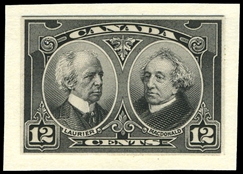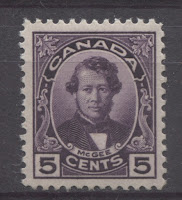The Historical Issue of 1927
Overview
Today's post will deal with the second commemorative issue of 1927 that was released on the same day as the previous set, the 60th Anniversary of Confederation Issue. Collectors call it the Historical Issue because it depicts historical figures only and includes three of the fathers of confederation who are never seen again on any Canadian stamp. The issue was actually intended to be released originally in 1926 when it was printed, but for some strange reason, the Post Office Department decided to hold it back and release it on the same day as the Confederation Issue, June 29, 1927.
The points of interest with this issue are much the same as the Confederation issue, but not quite as extensive. Consequently for an area of specialization, this issue will often be collected with the confederation issue.
One thing that I forgot to cover in my post about the Confederation issue are the paper and gum differences, which although subtle are collectible I believe. I will cover them briefly here, as this issue shares many of the same characteristics as the Confederation issue.
The Stamp Designs and Issue Quantities
5c purple - Thomas D'Arcy McGee 12c green Laurier & MacDonald
20,349,000 issued 5,273,000 issued
20c carmine La Fontaine and Baldwin
7,632,000 issued
Paper and Gum Differences
In common with the later dry printings of the Admiral Issue, both this and the Confederation Issue can be found with two different types of paper:
1. A white opaque wove measuring 0.004"-0.005" thick that shows no visible vertical or horizontal mesh. The gum on this paper tends to be a thicker cream gum that is quite shiny and streaky in its appearance.
2. A white paper that shows a very fine vertical mesh on the back. The gum on this paper is also cream in colour, but instead of being shiny and streaky, it is smooth, and satin in its sheen.
I have not done a comprehensive study to identify which values can be found with which types of paper and gum, but I would expect that all values of both sets could probably exist on both types. The following scans illustrate the differences:
Here we see the thick opaque paper that has cream gum that shows clear streaks.
The paper shown here does not show obvious mesh - you have to look hard to find it in places, but the paper is clearly thinner and more translucent compared to the paper above. The gum is also different, being completely smooth.
Shades
In handling many, many examples of these stamps over the years, I have noticed that all three of the stamps exhibit shade varieties. Again, these are probably best collected in blocks to highlight the differences. I have come across the following shades, as named in the Stanley Gibbons Stamp Colour Key:
- 5c blackish purple
- 5c deep dull purple
- 5c deep rose lilac
- 12c deep green
- 12c deep bright green
- 12c deep yellowish green
- 20c carmine red
- 20c brownish carmine red
There may well be one or two other shades that I have not identified, but the above list should give a pretty good representation of what exists.
Plate Flaws
I am aware that like the previous issue, the stamps of this issue can be found with plate flaws, though I have not seen any. Many of these were identified by Hans Rieche in one of his long out-of-print handbooks.
Plate Blocks
There were two plates used to print each value: A1 and A2. On the 5c, the inscriptions appear on the upper right and upper left corners of the sheet. So for this value, there are four collectible positions. The 12c had the imprints in the top centre of the sheet, so that there are only two collectible plate blocks for this value. Finally, the 20c had the imprints in the top centre and upper right corner of the sheet, so that again, there are four collectible positions of this value. The upper left blocks of the 5c are typically collected as blocks of 10, while the upper rights are blocks of 8. On the other values, they are usually collected as blocks of 6, except for the upper right positions of the 20c, which are collected as blocks of 4.
Proof Material

Those considering specialization and looking for a challenge will be pleased to know that this issue has no fewer than 24 known proof items. They are all a bit more expensive on average than similar items from the Confederation Issue, ranging from $200-$4,000 each. So you could spend a log time trying to locate all of them, and expect to face competition on the auction room floor. The BNA Proofs website whose link is provided below, has an excellent listing of all the known items, with the known quantities
To summarize, the known proof material consists of:
- 2 different progressive proofs of the 5c.
- 10 different die proofs of all values in issued colours.
- 5 different essays of the 12c in green and black, one of which has the value as 10c.
- 7 different trial colour proofs, all in black, except for one 20c in brown-carmine.
Imperforate and Part Perforate Varietes
Like the Confederation Issue, all values of this issue exist:
- completely imperforate all around as shown above;
- in horizontal pairs that are imperforate vertically;
- in vertical pairs that are imperforate horizontally;
The number of pairs that are estimated to exist of each value are 250 pairs.
Postal History
These stamps were technically replaced by the Scroll Issue, so they are a fairly short lived issue. The official periods of use for each value would be:
- 5c - June 29, 1927 to December 12, 1928.
- 12c - June 29, 1927 to January 8, 1929.
- 20c - June 29, 1927 to January 8, 1929.
The 5c could in theory have been used singly to pay the 5c new airmail rate, which took effect on August 24, 1928, as the 5c Airmail stamp did not appear until September 21, 1928, and the 5c Scroll did not appear until December of that year. However, this stamp is much more commonly found in large used multiples, which suggests they were used in multiples to pay registration and special delivery fees.
The 12c was designed for use on local registered letters, which is indeed how it will usually be found when on cover. The 20c was designed for parcel use of for special delivery use, however it is unusual to find single usages of this value on cover. A worthy challenge is to look for more expensive multiple weight registered covers to locales outside Europe, like Asia and South America.
First day covers are scarce for this issue and highly desirable, listing in Unitrade for a minimum of $150 per cover.
5-Hole OHMS Perfins
All three values can be found with the 5-hole OHMS perfin. As with the Confederation Issue, it may be possible to find up to 8 different orientations of the perfin as well as double perforated varieties. These are all very scarce stamps, so great care has to be taken to watch for forged perfins. Mint examples are almost non-existent as well, so again, if you see a mint example being offered for sale, exercise great care and learn the die characteristics of the genuine 5-hole perfin by looking at a cheaper known genuine stamp like a low value Arch issue from 1930-1931.
This concludes my post about this beautiful commemorative issue. To view the stamps that I have for sale from this issue, click on the following link:








انا منذ صغري و انا مهتم بجمع الطوابع و البطاقات البريدية و كذالك النقود و لقدذ توقفت سنة 1988 عن ذالك و لكن عاودني الحنين الى ذالك .
ReplyDeleteمع العلم مجموعاتي كلها موجودة في مكتبة المنزل.
انا منذ صغري و انا مهتم بجمع الطوابع و البطاقات البريدية و كذالك النقود و لقدذ توقفت سنة 1988 عن ذالك و لكن عاودني الحنين الى ذالك .
ReplyDeleteمع العلم مجموعاتي كلها موجودة في مكتبة المنزل.